Introduction
The domain of archiving is like many other disciplines prone to transformation particularly driven by the tremendous advancement entailing progression even in the fronts of technology as well emerging challenges and needs that are driving change in the way archiving has been done in contemporary history and archeological disciplines.
Achieving is a vital discipline in considering the needs of the archival and knowledge warehousing across socialogy, oral history and cultural heritage disciplines. The archiving disciplines are undergoing re-thinking and transformations whose dimensions and dynamics will be explored and illuminated in this qualitative research paper.
The research paper aims to explore the aspects of existing methods and techniques of archiving across various history domains. The research paper also aims to illuminate the relationship surmised and indeed existing between various archiving methods and techniques in use today versus mainstream archiving theories. I this premise the paper will illuminate the extent to which various archiving theories and some of their tenets are practicable in actual archiving processes. By extension the research paper will asses the impact of technology on the nature and dynamics of archiving in contemporary history domains spanning social, oral history and archeology, etc. The paper will feature a case study aimed to illuminate the practicability and essence of archival methods and techniques with special focus in archeological site reinterpretation.
Literature Review
This research exercise is not being conducted in a vacuum. The research exercise fits into a broad body of knowledge which has had numerous contributions from various scholars, researchers, professionals and students who have carried similar or related research exercises. Also; the scope and objectives of this research endeavor occur within related and implied theoretical, ideological and philosophical frameworks which largely influence the disciplines of business. As such the researcher is spurred to consider the multiple contributions relevant and related to this research endeavor. The researcher will present a literature review conducted in locating the object of this study within the broader confines of the bodies of knowledge in focus. The literature review component serves as the qualitative thrust aimed at drawing nuances around the particulate aspect of archival techniques and methods in contemporary disciplines.
Jennifer Platt (2003) notes that general knowledge has implied that there are different yet fairly lucid intellectual traditions in the domains of sociology that are closely linked with heavy reliance on documentary sources. These according to the scholar may be in form of quantitative content analysis and historical study, sociology of literature, linguistics and ethno-methodological as well as personal documents. Platt (Opcit) takes a thrust at enunciating problems that face researches and historians in archiving documents or making use of archived documents for research and other purposes. The scholar cites that the sticking issue normally borders on establishing of the authenticity of the document. The scholar notes that even before getting to the issue of the document’s reliability one may have to deal with the challenges of ascertaining whether the relevant documents of an intended undertaking are available. Then; enters the problem of sampling. One the challenges a historian or researcher either doing archival work or research work will have to grapple with is the challenge of formulating and executing a feasible and appropriate sampling technique that will ensure that there is adequate representation in the cross section of selected material for research or archiving purposes (Jennifer Platt 2003) The other problem here culminates from the fact that some documents are partly reliable to the fact that some sections of particular documents have their authenticity unverifiable”. The scholar has noted that this particularly lays a towering challenge when it comes to the need to classify or categories the resource (document) as reliable or not in definite terms.
In this aspect Platt argues that it will also be notably difficult to decide on what inferences and implications to draw form a document on masters other than the veracity of its factual assertion. The nature of such of problems will vary from one research type and thrust to another. This calls for feasible archiving methods and techniques that will ensure that preserved data for archival reference and research endeavors is authentic and has no compromised and unverifiable historical matter.
Platt (2003) argues for the implementation of the adequate and appropriate procedure and ascertaining the authenticity of the documents either for archival of research endeavors. The scholar points out that there are too many instances where documents can be classified as authentic member of a particular documentation class for in which it may be purported to belong. Examples given by the scholar enlist wills, legal documents, forged and falsified letters ,misquoted and wrongly referenced literary works attributed to wrong authors as examples of documents misplaced in categories in which they can be held and used as authentic when in actual fact they are not. The scholar notes that an inauthentic document may still be held as a resource of much interest yet it can not be fully and appropriately understood up until someone knows that the resource is in fact inauthentic. Particularly essential for this research scope the author underscores the importance of the implementing documents authenticating measures in archiving methods.
Part of the authenticity verification criterion as suggested by the scholar is to look closely in instances where there are reasons for suspicion on some part of a document or in instances where inauthentic examples of the categories are known to be common.
In carrying archival methods and techniques, historians or archivists have to pay particulate attention to forms through which a document may have been compromised for instance; achievers have to asses the levels of compromise on the contents and import of a document possibly arising from forms of reproduction such as translation, photocopying and many other forms of document reproduction.
Points of disparities can be the knowledge that the document has been transmitted through many copyists or where the document is known to have been transmitted by someone with particular inclines and interests, either intellectual or material, vested in the reproduction of the document. The other scenario may be case where the available copy is an adaptation of some secondary source which has acute indications of possible unreliability.
Limitations of Literature review
The research exercise has endeavored to solicit as much detail as possible under the scope and objectives defined and implied in the research task. Nonetheless the research exercise has not been in any way exhaustive and the researcher herein acknowledges the limitations of the research exercise owing to it’s encompass and goals among a host of other factors. The focus of the research, and as such the literature review, case scenario are thus limited to the time-frame, conceptual scope and objectives defined and implied in the research task.
Research Ideology and Methodology
Case Study and Qualitative Research models
To meaningfully frame the ideological, theoretical and conceptual platform for the research into the dynamics and aspects of archival methods and techniques in history it is imperative for the researcher to consider research models that will enable the researcher to bring a considerable proportion amount of research detail into perspective. The research thrust will adopt the two salient research theoretical frameworks, the positivist and non-positivist research paradigms. (Barker E: 2003) contends that the positivist theory entails the economic, behavioral, cognitive, motivational/trait/attitudinal, and situational viewpoints. According to the scholar the viewpoints are treated as the conventional perceptions as they came before the crafting of the non-positivist model.
In the views of the scholar, the positivist model which is still the principal framework reinforces the superiority of human reason and stresses that there is one objective reality which can be unearthed by scientific means. As such this design renders the world as an ordered and coherent environment with a well defined past, present and future. The tenets of the theory are clearly underpinned on the suppositions of rationalism. On the other end the contrasting non-positivist model holds the interpretive and post-modern viewpoints. Tenets of this model entail that the world be view as s composite social and cultural world contrary to the viewpoints of the positivist paradigm which hold the world in a rationality view that supposes a homogenous social fabric. Leveraging on the theoretical and principal tenets of largely, the non-positivist research theory, this research exercise will provide perspectives, findings and insights that will assist in the exploration of the dynamics that characterise archival methods and techniques in contemporary domains attached to historical heritage preservation.
Owing to its merits and scientific thrust in treating quantitative aspects of phenomena quantitative research is widely used in both the natural sciences and social sciences. The employment of the research paradigm spans various disciplines such as physics and biology to sociology and journalism. “It is also used as a way to research different aspects of education. The term quantitative research is most often used in the social sciences in contrast to qualitative research.” Thomas Kuhn (2001). Below is an overview of quantitative research presented by Thomas Kuhn (2001). According to the source quantitative research is generally approached using scientific methods, which include:
- The creation of frameworks, theories and hypotheses.
- The generation and development of tools and systems for measurement.
- Experimental regulation and manipulation of research variables.
- Gathering of empirical data.
- Organisation and analysis of data.
- Evaluation of collected results.
Scholars cited above state that quantitative research is often an iterative systematic process whereby gathered evidence is evaluated, theories and hypotheses tested and some formulated.
Secondary data
The research endeavor will also augment the primary data gathering and evaluations by conducting a secondary data gathering and evaluation thrust. Secondary data gathering draws much from published literature on the subject directly under the concept and scope focus of the research endeavor. According to Stewart and Kamins (1993), the use of secondary data is advantageous for a researcher since one can already evaluate the suitability of a data as it is already in existence, thus, much time can be saved. Before delving into secondary sources of data, an evaluation of potential secondary data is essential as a way of screening resources to establish the relevant sources of information which will provide relevant data germane to fulfilling research scope and objectives. The qualitative thrust will be conducted in from of a literature review which will present relevant and related insights and nuances from published literature on the subjects under probe. It is perceived that these research approaches will suffice to help arrive at meaningful positions regards feasible archival methods and techniques.
Case Study
The featured case scenario presents dynamics of techniques and methods in archival domains with particulate focus on archeological archiving. The case scenario seeks to illumine the essence and usefulness of archival methods and techniques in the reinterpretation of an archeological site, and making connections with the features of the site to its impact on modern society. The case features monumental Greek Archeological and architectural sites in relation to how archival techniques have come in handy for the usage of the archival to data in restoring (enacting) the site, applying site construction designs in the design of modern structures as well as the reinterpretation of the archeological relic for keen interest bodies including tourists.
Archival Techniques and archeological Site Interpretation
This section of the paper is aimed at presenting an exploration of the elements of an archeological site (re)interpretation in the premise of archival techniques and methods.. More specifically the case scenario presents the reenactment of and reinterpretations of the stylistics period of the Ancient Greek epitomized in the architecture of the ancient Greece according to the documentation and archives that have been preserved along with the site. This section presents aspects of site interpretation in archeological endeavors in a thrust that will also trace the relationship between the chosen site and other related archeological site enactments in other places all in the premise of the use of archival methods as means of maintaining and restating the significance of the site.
In contextualizing the essence of the chosen site the paper will also take a significant thrust in analysing particular architectural designs of ancient Greek as way of establishing the influence of ancient archival architecture in contemporary society. This will be incorporated into the scope and dynamics of the far reaching impact of the chosen archival site reinterpretation beyond the sites’ historical and archeological significance.
Archival and Archeological site
For the scope and objectives of this paper the selected site that will be explored in the premise of on ground archeological site interpretation is the Stoa of Attalos.
The chosen site is one of the highly esteemed relics of Greek History, the artifacts of the ‘Stoa of Attalos’. The Greek term ‘Stoa’ was used in ancient Greek architecture to refer to elements like walkways (known in Greek as porticos) which were made for the public. The Stoa of Attalos is held as one of the outstanding structures of the Athenian Agora. The structure was built under the rule of King Attalos and hence the naming after him.
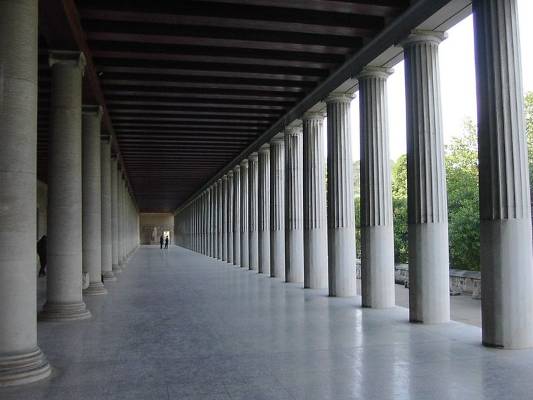
This image above shows the inner part of the restored Stoa of Attalos.
The site draws overwhelming pools of visitors with profile ranging from historians, Christians, architects, ordinary tourist, etc. The site is remarkable for its reinterpretations of Greece archeological architecture. The site enactment has incorporated provisions for public access around the entirety of the structure which has inlets to the interior arenas maintained fro public viewing. Below is a collage of visitor areas of the archeological site.

Francis D.K. Ching et al (2007) present a timeline based exploration of global archeological and architectural history spanning from 3,500 B.C.E to date. The scholars have underscored the significance of “links, influences and contrasts of the archeological progressions in history”. Francis D.K. Ching et al (2007). Any attempts at interpreting global archived and archeological architecture will not be complete without the consideration of the significantly influential Greek architecture archive on modern building designs. Visitors at the Stoa of Attalos Archeological Site are furnished with existent knowledge of Ancient Greek and how archeological architecture has been sustained through the period of 550-500BC as well as what is known as the Periclean era spanning 450-430 BC. Many architectural tourist are furnished with a significant part of the knowledge of ancient Greek building designs and models which has also been obtained from the Classical period of 430 – 400 BC. Francis D.K. Ching et al (2007) note, “Some archeological nuances on the characteristics of ancient Greek have been obtained from the Roman archeological architectural artifacts which are largely known to have drawn significant influence from Greek architecture”
Archival techniques, Site Enactment and Reinterpretation
The state funded, owned and managed site pulls site seers and tourists for its significance as the epitome of Greece architecture. The site is pelted particularly by the kind of visitors who seek to familiarize themselves with Greece architectural culture. The site has also been adopted by the state as Greek heritage. Part of the site management thrust entails the enactment of the site in close resemblance to the original masterpiece. This process relies heavily on the archival data on Greek Architecture. Information used for the enactment of the site has to be verified for authenticity to avoid gross misrepresentations. This has enabled the site management to restore the site in accordance to features of Greek architecture.
Wood was the common material used in Greek building constructions. Wood was used for construction structures such as roof beams. Other forms of matter such plaster were also used in the making of components like sinks as well as bath tubs. For wall structures builders used unbaked brick and for exquisite designs builders used limestone and marble. Limestone and marble were also used in palatial temple designs as well as in public buildings. William Rostoker et al (1981) outline, “The Greek are known to be some of very architecturally aesthetic community hence the heavy reliance on material like bronze and ornaments and other metals for decorative building detailing”. Building forms of the Classical period era can be classified into five types of structure which are funerary, recreational, civic, domestic and religious.
Architectural archeologists have preserved some of image and drawings artifacts of various ancient Greek architectural designs viewed as yardsticks for particular ancient Greek architectural categories and such have been used in the management and maintenance of the Stoa of Attalos.
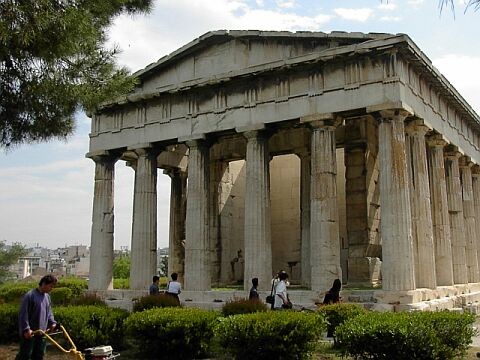
The Image above shows the western facade of the Temple of Hephaestus in Athens. The Temple of Hephaestus in Athens is one of the archeological preserves held together with the Stoa of Attalos as the standard design of Greek public buildings. The Temple of Hephaestus is categorised together with other ‘renoedn’ structures such as the temple complex at Selinunte, the Parthenon as well as the sanctuaries at Agrigentum. These buildings are held as the Greece archeological heritage.
The Greek temples are said to have been the paragons of the Greek aesthetic endowments as the Greeks were a religious community. Greek temples were designed in immaculate magnificence which has earned them recognition as the most outstanding designs of their time. Orjan Wikander (1990) notes, “The endurance of temple designs and their relative harmony have made the designs a de facto crafting influence for the last two millenniums in the archeological architectural tradition of the west”.
The reinterpretation of these entails the furnishing of the visitors to the sites with historical and archival Information on the significance and uses of these sites in their actual contexts. The reinterpretation processes articulate that the Greek theater designs were also exceptional designs in ancient Greek. These were used for public entertainment were people would come to watch tragedy and comedy performances. The theatres were also used for poetry and musical events. Theaters were usually built on hillsides in the peri-urban settings. Theaters constituted rows of tired seats structured around the central performance arena known as the orchestra. The ‘skene’ in Greek theater design refers to the low building behind the performance area which was used as the store-room while also serving as utility enclose for backstage activity. The “Epidaurus” is one of the most recognised theaters of ancient Greek.
Archival Techniques and Site significance in modern society
Francis D.K (2007) presents that interpretation is driven and based on philosophy that moves interpreters to assist audiences unearth and decipher the meanings and significance attached to the archeological sites from archival data. Part of this drive for the Stoa of Attalos site together with many other related sites with the archeological and cultural significance of the Stoa of Attalos, has been to educate the audiences on how the archeology of the Greek architectural and archeological artifact have influenced modern day architecture.
Interpreters at the Stoa of Attalos are governed by the core values of on ground site interpretations and definitions as well as the professional standards of archeological site interpretation. This is ensured and leveraged on the means through which the interpretation can be measured on the matter of how successful interpretation has functioned to give the audience a sense of the significance of the archeological sites to the understanding of the historical culture of the Greek as encapsulated in the archeological sites.
One of the top mainstream archeological sites in Greece which belongs to the same category as the Stoas of Attalos is the Stadia. In ancient Greek architecture the stadia also had a central part in cultural relics of ancient Greek architecture. The modern day Olympic Games were born in the Greek competitions. Orjan Wikander (1990) adds, “The Minoan Crete, the Mycenaean palaces of Peloponnese as well as Macedonian Palaces of northern Greece are some of the most recognised palaces of the ancient Greek to date.” It must be noted that in Classical era The Greece transformed inline with the ideals of democracy hence there were no palaces built for leaders in that period.
Part of the reinterpretation process for the site audience is education on the significance of these sites as well the influence of these sites in modern society. The site interpretation has been embedded with such attachment of the architecture and archeological heritage to modern day society as follows.
Visitors Experiences and Sites’ attachment to modern society
Visitors who inundate the Stoa of Attalos especially in prime holiday seasons are overwhelmed by the influence that Ancient Greek archeology has had in contemporary architecture. Various modern structural designs have been evidently modeled under the influence of the ancient Greek designs. The attachment of the sites significance in relation to features in modern society is done in cross reference to other sites such as Alex Theatre in Los Angeles to broaden the site visitors’ (audiences) perspectives on appreciating the essence and the significance of this archeological heritage. This is possible thanks to archival data stored on the designs of monumental Greek sytructures.
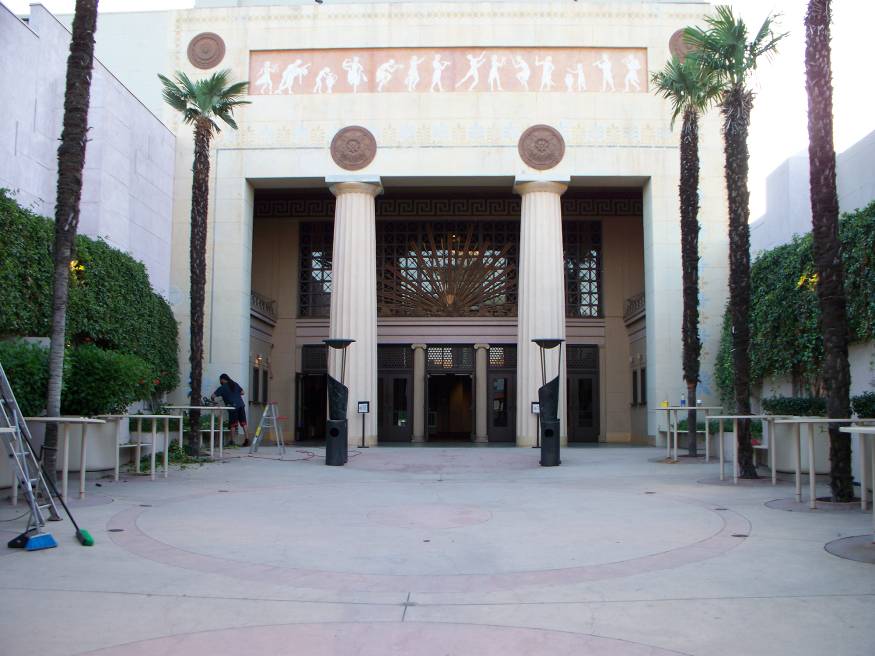
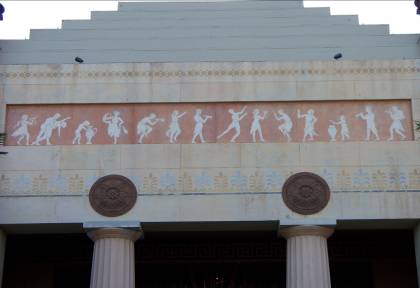
The design of the Alex Theater formerly known as The Alexander entails outstanding elements relatable to Classical Greek as well as Egyptian architectural histories. The massive Doric columns as well as the frieze of Egyptian dances are undeniable resemblances of the elements of the Ancient Greek and Egyptian theater designs. See J. D et al (1965) notes, “The unique and exceptional interior has remarkable neo-classic Greek and Egyptian architectural adaptations, related to the Greco-Egyptian period of Ptolemaic Egypt.”. The scholars also outline that, “The protracted walkway and courtyard distinguishing the ticket enclosure from the lobby was adapted from the famous Grauman’s Egyptian Theatre in Hollywood”

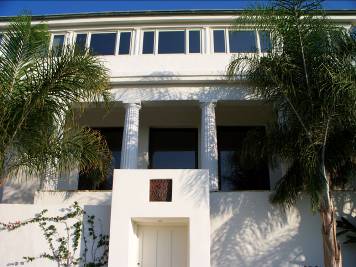
The Arzner/Morgan Residence
This building was built for pioneering woman film director Dorothy Arzner. The eclectic residence features includes a second-floor Doric-colonnaded loggia. The pervading rectangular shape of the building resembles the ancient Greek temple designs. One striking aspect on the Arzner/ Morgan Residence related to the typical Greek architectural colonnaded portico of columns which surrounds the building. Arzner/ Morgan Residence structure thus closely resembles the structures of the Temple of Athena Nike and the famous Parthenon. William Rostoker, (1981) notes, “Archived data reveals that Ancient Greek building designs some designs constituted projecting head of columns making up the entrance ( known as the prostyle) while others were complement by what called the ‘pronaos’ façade of columns protracting to the ‘cella”.
Many site visitors have indicated that they are overwhelmed by the striking similarities in the column structures of the two building designs, the Arzner/ Morgan Residence and the famous Parthenon (Which is reinterpreted similarly to the Stoa of Attalos) displayed below.
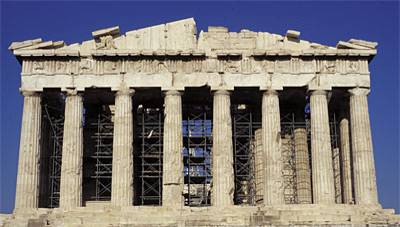
The picture above shows the façade of the famous Parthenon. The façade is made of the projecting colonnaded portico of columns which surround the building.
The Parthenon foundation was made of limestone while on the hallmark columns were made of marble. Architects of the famous structure are known to be Iktinos and Kallikrates, Vitruvius and Karpion. The Parthenon was dedicated to the goddess again demonstrating the acute religious inclination of the Greece.
Francis D.K. Ching et al (2007) note, “By use of relevant and authentic archival data the temple was modeled in resemblance of the ‘Doric order’ marked by the hallmark eight columns at the front as well as seventeen other columns on the sides in tandem with designated ratio of 9.4.” According to the insights of the scholars, “This ratio was a salient design framework for the vertical and horizontal structuring of the building as well as other proportionalities of the design which included the spacing of the columns and the establishment of their height”
It is notable that the design of the Arzner/ Morgan Residence has overwhelming features of resemblance to the Parthenon design. The architects of the modern structure must have relied closely of the ancient architectural models to erect the residence and tailor it in profound reminiscence of the famous Parthenon temple.
One such structure relatable to Ancient Greek architecture is the legendary Greek Theater. The Greek Theater which was erected in 1929 is modeled is unmistakable resemblance of the ancient Greek theater which in the olden Greek times were normally built on hillsides of the urban territory thresholds. Remarkable aspects of the Theater built on 1929 include the lack of a facade and seating arenas design which is closely related to the interior designs of the ancient Greek theater.
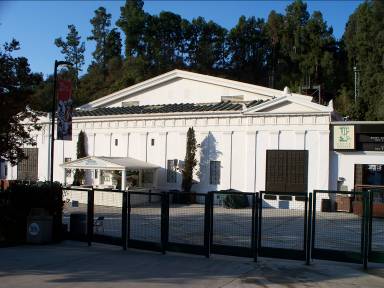

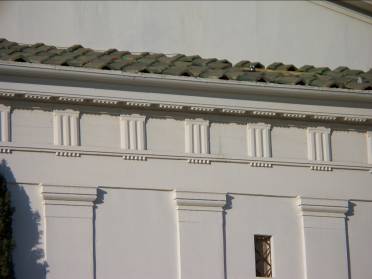
The Greek Theater built in 1929, rightfully named after its typical ancient Greek architectural model, is an over 5000-seat amphitheater situated at the Griffith park in Los Angeles California. One of the theater’s design elements that resemble ancient Greet building structures is the amphitheater stage which closely typifies the ancient Greek temple. The Theatre is structured as serene outdoor theatre in the scenic nature-environment setting. The striking features about that location of the theater is that it is nestled within the environs of typically hilltop setting which unmistakably resembles ancient Greek theaters which were normally located around urban area hillsides. Like the olden times Greek theater the Legendary Los Angeles Theater is used as a venue for all kinds and creed while playing venue to numerous big names in the entrainment circles.
The influence that Greek Architectural archeology has had is far reaching influences which can be traced in various buildings and architectural models the world over. In US alone evidence of the influence is overwhelming. The Pediments, Doric, and Iconic column elements used in the Capitol Building and the White House in washing D.C are some of the numerous exhibits of the influence of Greek archeology in modern architecture. The remarkable and hallmark Greek architectural Corinthian style of column construction is evident in numerous church and state buildings across the world. The dentils pediments as well as friezes with the associative aspect of proportionality and symmetry are unmistakable relics of the substantial influence of Greek architecture in modern building designs.
The future plans for the Stoa of Attalos archeological site entail the decentralisation of the archeological site. The decentralisation thrust by the Greek State entails the setting up of specialist affiliations that will encompass the core archival and archeological units. These future developments will be matched with the remodeling of the archeological site’s museum art gallery. The future plans also hold that more important and historic conventions particularly those with direct link to the Greek heritage, history and culture will be held at the site as the way of promoting the archeological site. As such the plans entail the erection of conference accommodation for such gatherings. These developments are expected to surmount the threats of site deterioration which is exacerbated by protracted negligence by governing authorities. The decentralisation thrust is perceived to assist in allocating some archeological site maintenance and management to relevant academic bodies such as the state institutes of the country’s cultural heritage and archeology.
Archival techniques and methods are vital across domains in historical record warehousing. Technological advancements have come in handy by offering the most effective means of storing data. Technological advancement has enhanced means to foster easy accessibility and availability of archival data to researchers and any parties interested in historical records for various reasons. The tapping of the merits of information technology (IT) for the management and availability of archival data varies from one society to another owing to varying policies and principles regarding the handling of either business, cultural or historical record. Debate is also raging in various data preservation circles on the matter of how far accessibility should states allow for the opening of archival data for the public. Despite the foregoing, it is evident from the featured case scenario that archival techniques and methods play a critical role in modern society and further researches can be conducted to establish feasible means of striking the balance between maintaining privacy of certain records as well as ensuring that modern society develops from stored archival data.
References
Craig, Barbara L, 2001,Archives Theory, Archival Practice, Archives History: Three Solitudes or a Trinity? Journal of Information and Library Science.
Crockett, Margaret, 1993, The theory of electronic records and archive management: A preliminary outline. Journal of the Society of Archivists.
Eastwood, Terry, 2001, How goes it with appraisal? Archivaria, Autumn, PAC, NYK.
Duranti, Luciana, 2005, The archival body of knowledge: Archival theory, method, and practice, and graduate and continuing education. Journal of education for Library and Information Science.
Stielow, Frederick J, 2007, The impact of information technology on archival theory: a discourse on an automation pedagogy. Journal of education for library and information science.
Francis D.K. Ching, Mardk M. Jarzombek, and Vikramaditya Prakas,2007, A Global History of Architecture, Hoboken, NJ : John Wiley & Son.
Platt Jennifer, 2006, some specific problems of documentary research, McGraw Hill, NYK, US.
G. M. A. Richter, 1967, Handbook of Greek Art, Millennium Press.
Marilyn Y. Goldberg, 1983,“Greek Temples and Chinese Roofs,” American Journal of Archaeology.
Orjan Wikander, 1990, “Archaic Roof Tiles the First Generations,” Hesperia, Vol. 59, No. 1.
Quenell, Marjorie and C.H.B, 2001, Everyday Things in Ancient Greece. New York, G.P. Putnam’s Sons.
Scranton, Robert L, 1995, Greek Architecture, New York, George Braziller.
See J. D. and A. B. Beazley, 2003, Greek Sculpture and Painting, Oak Books, NYK.
William Rostoker; Elizabeth Gebhard, 1981,“The Reproduction of Rooftiles for the Archaic Temple of Poseidon at Isthmia, Greece,” Journal of Field Archaeology, Vol. 8, No. 2.